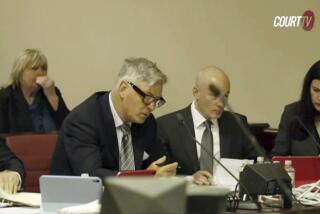Six Panelists Picked by Lot : Jury Begins Deliberations in Suit on Smoker’s Death
- Share via
NEWARK, N. J. — A six-member federal court jury began deliberations Tuesday in a trial that charges three tobacco firms with fraud and conspiracy in connection with the death of a smoker.
The jurors were chosen by lot from a pool of 11 who heard the case. They went to work in the early afternoon and recessed for the night without reaching a verdict.
The trial, which began Feb. 1, is the longest-running tobacco liability trial in history. Because of its expected length and the possibility of jury attrition, U.S. District Judge H. Lee Sarokin originally impaneled a pool of 12 to hear the evidence, one of whom was excused early in the trial.
Jury Includes Smoker
After Sarokin read 72 pages of jury instructions, a court clerk picked six names from a small wooden drum. The panel of three men and three women includes two former smokers and the only current smoker among the original pool of 12.
They will decide whether Philip Morris, Lorillard Inc. and Liggett & Myers are responsible for the death at 58 of Rose Cipollone, who contracted lung cancer after 40 years of smoking their brands. A unanimous vote is required for a verdict.
Cigarette manufacturers have never lost or settled a smoker death claim since the first ones were brought against them in the 1950s. This case has attracted wide attention because it is the first in which a plaintiff amassed thousands of internal documents after winning the right to search the files of tobacco companies, their consultants and industry organizations. Regardless of the outcome of this case, this evidence will become available in other cigarette cases around the country, of which nearly 100 are pending.
Tobacco Firms Shielded
However, this lawsuit, which was continued by Antonio Cipollone after the death of his wife in 1984, has been weakened by a federal appeals court ruling that the law that required a warning on cigarette packs in 1966 shields tobacco companies from many claims. As a result, the issues before the jury relate almost exclusively to the industry’s conduct before 1966.
All three companies are accused of fraudulently misrepresenting the hazards of smoking before 1966 and of taking part in an industrywide conspiracy to distort those risks and attack factual information so that customers would be lulled into continuing to smoke.
In addition, Liggett, whose Chesterfield and L&M; brands were smoked by Cipollone before 1966, is accused of failing to warn of the risks of smoking and of breeching a warranty, purportedly expressed in its ads, that its cigarettes were safe.
The cigarette companies contend that Cipollone smoked because she wanted to and that nothing they said or did caused her to continue the habit. Liggett has claimed that it had no duty to warn of the risks of smoking before 1966, because those risks were widely described in the popular press. The cigarette companies contend also that the type of lung cancer Cipollone had is not typically associated with smoking.
‘What the Doctor Ordered’
In the 1950s, ads for Chesterfield urged smokers to “Play Safe” by smoking the brand and claimed: “Nose, Throat and Accessory Organs Not Adversely Affected By Smoking Chesterfields.” L&M; was advertised as “Just what the doctor ordered.”
In his instructions to the jury, Sarokin said that, if jurors considered such statements to be warranties, Liggett could be found liable even without proof that Cipollone specifically relied on the statements.
Regarding the other three claims, however, Sarokin said there could be no liability unless jurors concluded that the behavior of the companies was a “substantial contributing factor” in Cipollone’s continuing to smoke.
More to Read
Inside the business of entertainment
The Wide Shot brings you news, analysis and insights on everything from streaming wars to production — and what it all means for the future.
You may occasionally receive promotional content from the Los Angeles Times.










